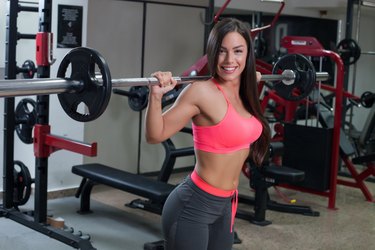
The behind the head military press is a hotly debated topic. While it is a staple exercise in many bodybuilding and strength routines, and can offer numerous benefits, it also carries a certain degree of risk. Performing it too often, or with poor form, can lead to injury.
Technique & Muscles
Video of the Day
Set up for a behind the head military press in much the same way you would for a regular military press. Your feet should be close together, your legs straight and torso upright. You then press the bar up from behind your head, until your arms are held straight with your elbows locked out. The main muscle worked is your anterior deltoid -- the muscle in the front of your shoulders. But your medial and posterior deltoids, traps, triceps and core all play a role too.
Video of the Day
Benefits
The main group of trainees to benefit from behind the head pressing are Olympic weightlifters. Olympic lifting requires a great deal of shoulder mobility and strength, as both the lifts -- the snatch and the clean and jerk -- finish with the barbell held with straight arms overhead, with the weight slightly behind the head. According to Glenn Pendlay, owner of Wichita Falls Weightlifting Club, behind the neck presses are great for helping to learn correct bar positioning and developing the necessary mobility for Olympic lifting.
Drawbacks
During behind the head pressing exercises, you have to pull your shoulders back and angle them out slightly to perform the exercise. Strength coach Sean Barker writes in his article, "5 Exercises You Shouldn't Be Doing," that behind the head pressing places your shoulders and rotator cuffs -- the group of muscles which support the shoulder, in a vulnerable position, thus increasing your risk of injury.
When to Use
Because of the potential contraindications of behind the head military presses, you should only do them regularly if you have excellent shoulder flexibility or a specific need -- if you are looking to develop upper body mobility for Olympic lifting, for example. However, Charles Poliquin, owner of the Poliquin Performance Center for elite athletes believes that behind the head presses can also be an assessment tool to see if you have any muscular or strength imbalances that need targetting in your training routine.